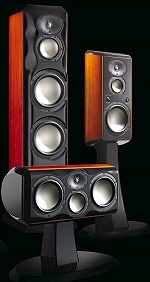Introduction
The Revel Ultima speaker line made its debut in 1996. This, the first loudspeaker line with the Revel moniker, established Revel as one of the premier loudspeaker manufacturers. Attaining this status at the onset was no accident. Unlike a new startup, Revel was seeded within a large corporation, Harman International, and had at its disposal vast R&D resources and an experienced team. The recipe for success was there from the beginning.
Once the Ultima line was populated, Revel spent subsequent years applying this know-how to establish new lines at lower price points. The Performa line came first; this was followed by the Concerta line. Both lines have received favorable reviews at Secrets.
Specifications
- Studio2 Floor-standing
- Design: Ported, 3-Way
- Drivers: One 1″ Beryllium Dome Tweeter, One 5.25 Titanium Midrange, Two 8″ Titanium Woofers
- MFR: 31 Hz – 18 kHz ± 1.5 dB
- Sensitivity: 87.7 dB/W/M
- Crossover Points: 230 Hz, 2 kHz
- Nominal Impedance: 6 Ohms
- Dimensions: 46.25″ H x 13.75″ W x 20.5″ D
- Weight: 140 Pounds/Each
- MSRP: $15,998/Pair USA
- Voice2 Center Channel
- Design: Sealed, 3-Way
- Drivers: One 1″ Beryllium Dome Tweeter, One 5.25 Titanium Midrange, Two 8″ Titanium Woofers
- MFR: 65 Hz – 18 kHz ± 1.5 dB
- Sensitivity: 89 dB/W/M
- Crossover Points: 235 Hz, 2 kHz
- Nominal Impedance: 6 Ohms
- Dimensions: 24.2″ H (with Pedestal) x 25.5″ W x 14″ D
- Weight: 74.5 Pounds/Each
- MSRP: $7,999Â USA; Optional Pedestal $599
- Gem2 Surround Speakers
- Design: Sealed, 3-Way
- Drivers: One 1″ Beryllium Dome Tweeter, One 4″ Titanium Midrange, One 8″ Titanium Woofer
- MFR: 75 Hz – 18 kHz ± 1.5 dB
- Sensitivity: 86.4 dB/W/M
- Crossover Points: 400 Hz, 2.3 kHz
- Nominal Impedance: 6 Ohms
- Dimensions: 24.2″ H (with Pedestal) x 12″ W x 5.4″ D
- Weight: 38 Pounds/Each
- MSRP: $9,998/Pair USA; Optional Pedestals $1,398/Pair
- Revel Speakers
I have reviewed a couple of Performa systems over the years and compared them to the Ultima Studio and Voice loudspeakers, which have anchored the sound of my home theater for a long time. In my opinion, the crossover point came with the launch of the F52. During this review, I found that the F52s performed better than the Studios in many regards. Most notably, the tweeter was excellent as was the tweeter/midrange integration. It had been over a decade since the launch of the Ultima line, and the time had come for a makeover!
By now, the plans for the Ultima2 line had been made public. Kevin Voecks talked about the Ultima2 line in the mini-interview which accompanied my review of the F52/C52 Performa loudspeakers. The waiting game started. Fast-forward to May, 2007 and the Ultima2 line started shipping.
Â
Â
What Meets the Eye
The design of the Ultima2 is a departure from the distinct appearance of the Ultima line. The unique modern look has been replaced by conservative styling which is simple, yet elegant. For non-dedicated listening spaces where appearance is an important consideration, this change might be welcome since the speakers are likely to blend well in more surroundings. The finish is limited to two options: high-gloss black or high-gloss mahogany. This may be an issue with some, but the high-gloss black finish works for me.
While the styling is different, there is still a striking resemblance between the old and the new. That has to do with the transducer configuration. When I talked to Kevin Voecks about this a while back, he said that the design of the Ultima2 was seen as a ground-up effort; every aspect of the design was put on the table. When they revisited the transducer configuration (transducer dimensions, crossover frequencies, etc.) for the Studio2 and Voice2, they pretty much came back to the design of their predecessors. That must have been a good feeling!
Transducers and Cabinet Design
The Ultima2 series employs new transducer designs offering greatly reduced distortion levels. The midrange and woofers utilize titanium diaphragms with dual-neodymium magnetic motor systems and oversized voice coils. The tweeter, shared across all the Ultima2 models, is a pure beryllium dome, a first for Revel. The tweeter is housed in a third-generation waveguide which provides excellent integration with the mid-range unit.
As is customary with all Revel loudspeakers, high-order crossovers are used. The use of a high-order crossover optimizes both on- and off- axis response, the importance of which Revel has emphasized from the beginning. Separate filter boards are used for the woofer, midrange, and tweeter to prevent any mutual interference between them.
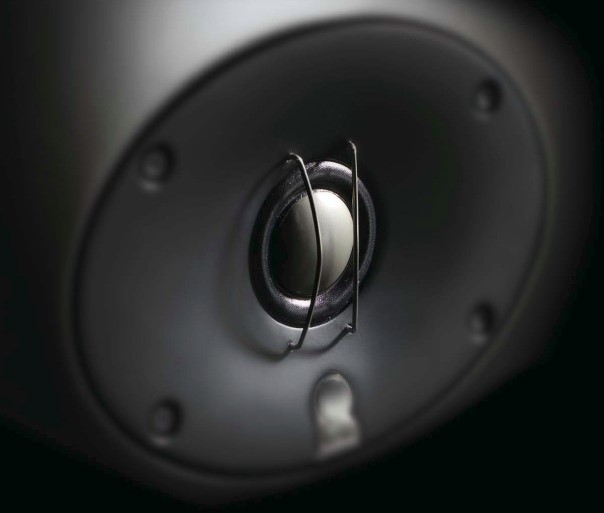 The cabinet is an integral part of any loudspeaker. While aesthetics are important, of equal importance, arguably more so, is its effect on a loudspeaker’s sonic quality. To meet this need, the Ultima2 models have a front baffle which has been acoustically designed to minimize diffraction. The side-walls are also curved to aid the off-axis response. The only exception here is the Gem2, whose shallow profile prevents some of these design options. All models use 1†thick walls and employ extensive internal bracing.
The cabinet is an integral part of any loudspeaker. While aesthetics are important, of equal importance, arguably more so, is its effect on a loudspeaker’s sonic quality. To meet this need, the Ultima2 models have a front baffle which has been acoustically designed to minimize diffraction. The side-walls are also curved to aid the off-axis response. The only exception here is the Gem2, whose shallow profile prevents some of these design options. All models use 1†thick walls and employ extensive internal bracing.
Â
Â
The Ensemble
For this review I requested a Studio2 pair and a Voice2 to anchor the front. A pair of Gem2s was relegated to surround sound duty.
The Studio2 floor-standing loudspeaker is a reflex design featuring the following driver complement: a 1†tweeter, a 5.25†midrange, and two 8†woofers. Crossover frequencies are specified at 230 Hz and 2 kHz. The port is down-firing on the Studio2; the narrow profile on the back probably dictated this change from the rear-firing port used on the Studio. As is typical with all Revel speakers, acoustic controls are provided to tailor their response. A Tweeter Level switch allows the output level to be adjusted in 0.5 dB increments from -1 dB to +1 dB. A Low Frequency Compensation switch provides three settings: Normal, to be used if the Studio2 is located 3+ feet away from the walls; Contour, to be used if the bass sounds bloated; and Boundary is to be used if the Studio2 is situated less than 2 feet from the walls or is installed within a cabinet. Anyone buying the Studio2s will hopefully have a qualified installer who can figure out the best placement and setting combination guided by some in-room measurements.
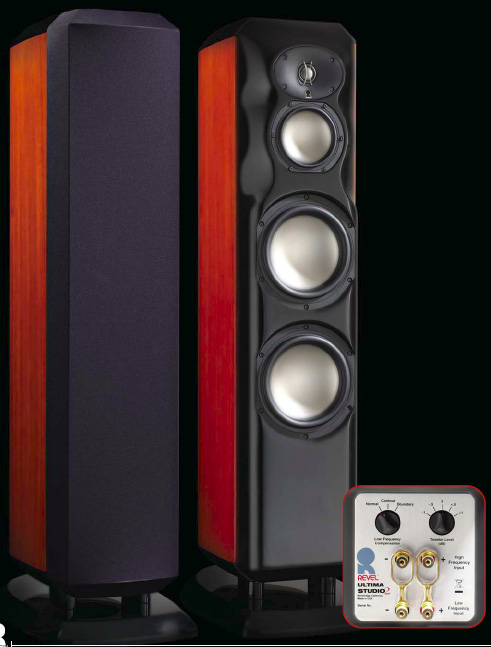
Â
Â
Â
Â
Â
Â
Â
Â
Â
Â
Â
Â
Â
Â
Â
Â
Â
Â
Â
A notable absence on the Studio2 is the rear tweeter. When asked about this omission, Kevin mentioned that it was indeed included in the initial design. When they measured the power response of the new tweeter coupled with the newly designed waveguide, they found the response to be already what they wanted, so . . . .
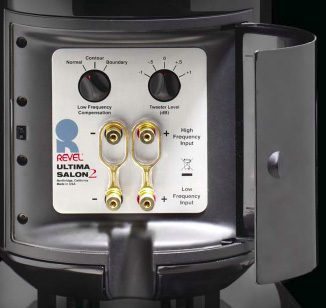
Â
Â
Â
Â
Â
Â
Â
Â
Â
The Voice2 center channel loudspeaker is a three-way horizontal design featuring the following driver complement: a 1†tweeter, a 5.25†midrange, and two 8†woofers. Crossover frequencies are specified at 235 Hz and 2 kHz. Revel has always utilized a three-way design in their center-channel models. The transducer geometry is such that the tweeter and midrange units are vertically aligned with a woofer on each side. Such designs generally provide a smooth off-axis response from a horizontal design, although this is not a guarantee if not followed by sound design practice. This is pretty much a requirement for a social application such as home theater.

Â
Â
Â
Â
Â
Â
Â
Â
Â
Â
Â
Â
Â
Â
Â
Â
Â
Â
Â
Â
Â
Â
Â
Â
Â
Â
Â
A Tweeter Level switch offers the same functionality as the control on the Studio2. A Low Frequency Compensation switch is also offered, however, the designations, and their corresponding use, are different from what is offered on the Studio2. There are three options: Flush to be used when the Voice2 is placed in a bookcase or wall unit; Stand - to be used if it is placed on top of a video monitor or a shelf; and Stand + if it placed on the optional pedestal stand.

Â
Â
Â
Â
Â
Â
Â
Â
Â
Â
Â
Â
Â
Â
Â
Â
Â
A rounded base with four attached feet is included with the Voice2. The curved base allows the Voice2 to be tilted upwards or downwards. Two screws are provided to lock in the position once the desirable tilt has been achieved. Note that the original Voice did not include a base, so this is a nice addition providing an out-of-box solution for shelf or monitor placement. For floor placement, an optional stand can be purchased from Revel. This is the option I chose. The base plate which ships with the Voice2 mounts on the stand and tilt can be similarly adjusted. Tilt adjustment was not an option with the Voice stand, so this is a welcome change.
The Gem2 is a three-way multi-purpose speaker intended for use in either a floor-standing or wall-mounted configuration. This is also a speaker which will likely serve as a surround speaker in a multi-channel setup, as was the case for this review, although someone with an unlimited budget should aim for five Studio2s! Unlike the other Ultima2 models, the Gem2 is compact and maintains a shallow profile, which was undoubtedly a requirement for wall-mounting. It features the following driver complement: a 1†tweeter, a 4†midrange, and an 8†woofer. Crossover frequencies are specified at 400 Hz and 2.3 kHz.
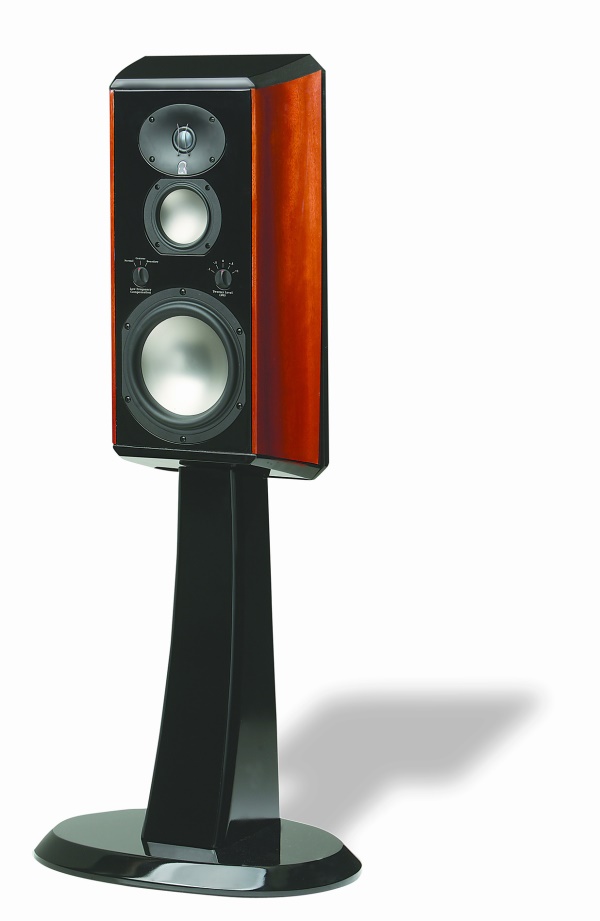
Â
Â
Â
Â
Â
Â
Â
Â
Â
Â
Â
Â
Â
Â
Â
Â
Â
Â
Â
Â
Â
Â
Â
Â
Â
Â
Â
Â
Acoustic controls are also provided on the Gem2. The Tweeter Level control functions the same way as the Studio2. The Low Frequency Compensation control alters the response depending on the proximity to a boundary or some room mode coupling. Three settings are provided: the Normal setting applies when the loudspeaker is located 3+ feet into the room; the Contour setting is available when some muddiness is encountered in the mid-bass; and the Boundary setting applies when the loudspeaker is mounted on a wall or inside a cabinet. Two additional settings, On Axis and Off Axis, are provided depending on whether the loudspeaker is on or above the listening axis. Select the Off Axis setting to tilt the sweet spot down when the Gem2 is mounted 5 feet or higher.
The Gem2 ships with a wall-mount bracket. For a floor-standing install, an optional stand can be purchased. The wall-mount bracket needs to be fastened to the stand, and then the Gem2 slides into the bracket just like it would for an on-wall installation. Before doing this however, the speaker wire needs to be fed through an opening in the stand.
All the new models use a magnetically attached grille. The loudspeakers are attractive to look at sans grille; however, care must be taken to prevent eager little kid fingers from exploring the transducers! All models facilitate either bi-amplification or bi-wiring. Threaded inserts are provided to screw in two types of ends: Spike, to be used when the loudspeaker sits on a carpet, and Glide, for when the loudspeaker sits on a wooden or tile floor.
Revel has designed dedicated surround loudspeakers in the past with configurable dispersion patterns: monopole, bipole and dipole. The Ultima2 series is the first to offer no dedicated surround loudspeaker. Revel believes that a surround speaker is best served by a monopole design; therefore any Ultima2 model can be relegated to surround sound duty, although the Gem2 is likely to be the popular choice here. As you will read later in the review, I don’t think that this is a big omission.
Â
Â
Setup
The primary purpose of this review was to review these loudspeakers in a multi-channel setup. As such, a crossover frequency of 80 Hz was used, and the bass duty was relegated to a pair of Revel B15a subwoofers. The audio calibration was performed by Bob Hodas. One big change from before was the relocation of one of the two subwoofers which greatly improved the bass response. There is no substitute for accurate in-room measurements and someone who has the experience of tuning many rooms. This turned out to be a good investment, one I wish I had made earlier. The Gem2s were stand mounted and placed directly to the side of the listening location, adjacent to the side-walls.
The front L/R placement was not optimized with full-range reproduction in mind. When configured in this manner, their coupling with the room modes produced a sub-optimal response. As a result, listening in this configuration was confined to a brief period.
The Low Frequency Compensation setting was set to Stand+ and Boundary for the Voice2 and Gem2 respectively. All the other acoustic controls were left at their default settings. Note that with the Studios, I needed to trim the level of both the front and rear tweeters in order to achieve the right balance.
The Sound
In my review of the Performa F52, I noted the exceptional integration of the midrange and tweeter. The sound seemed to emanate from a point-source. This notable improvement over the Studio was something I was looking forward to hearing in the Studio2. It did not take long to hear this improvement. Points in space had a tighter definition; borrowing some video terminology, it was as if the image has a tighter focus. There was a three dimensional quality here which was evident on Vivaldi’s The Four Seasons (Sony Classical, SK51352). The Studio2s provided an effortless presentation bringing the string instruments to life. There was no sign of compression when listening to music at a high volume level, and the detail in the quiet passages stood out regardless of volume level.
Patricia Barber’s Café Blue (Premonition Records, PREM-737-2) is another reference disc which takes an occasional spin during a review. Track 11, “â€Nardis†has a percussion solo midway through the track which pans across the front. The imaging here was excellent. The new tweeter has a remarkable level of transparency and is able to preserve all the detail in a recording. You could hear the delicacy of the cymbals when they were brushed or struck along with these notes lingering in the air as they decayed. This sounded superb.
I did briefly configure the Studio2 to run full-range and found them to perform very capably in this regard. The Studio2 could reproduce deep bass without any audible strain. In my setup, however, I did prefer the Studio2/B15a combination. The bass was deeper and smoother, but that was not surprising given that placement optimization was carried out with this setup in mind. In addition to the placement, the parametric-equalizer controls had also been exercised on each subwoofer to even out the combined response. The Studio2 does provide acoustic controls which can be used, but those filters have a broad response. It would have been nice if a multi-band, or even a single band parametric equalizer had been provided on the Studio2. For me, however, this is not much of an issue since I am an advocate of using a subwoofer even with full-range loudspeakers.
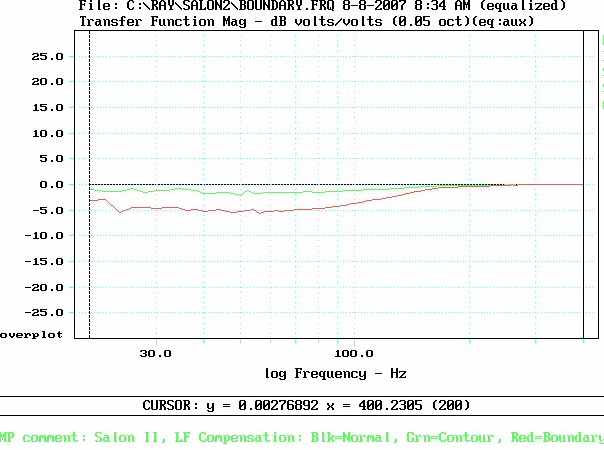
I greatly valued the Ultima Voice for its ability to reproduce the human voice. The Voice2 does that even better: voices took on an even more natural form, and there were no boxy or chesty colorations to speak of. This was true of both male and female voices. I watched many movies during the course of this review and found dialogue reproduction to be just wonderful.
The Ladysmith Black Mambazo’s SACD, Long Walk to Freedom, is a prime example where the cohesiveness of this multi-channel setup gets highlighted. This is a mix where unlike the gimmicky sound effects which typically linger in the surround channels in a movie, you get voices in the surround channels. The first track on this album, “Nomathemba”, showcased the importance of a high quality surround loudspeaker. Voice pans had a consistent timbre resulting in an immersive, continuous sound field. The consistency was not perfect, but that is most likely due to a difference in how each loudspeaker interacts with the room, rather than a fault of the loudspeaker itself. Even so, this was the best timbre matched set that I have ever reviewed.
The Eagles: Farewell 1 Tour – Live From Melbourne HD DVD is a concert disc with a lively atmosphere which gets heartily conveyed. You can sense the excitement of the crowd as they cheer and applaud the band. The mix makes good use of the surrounds, and the part which surprised me here was how effective the Gem2s were at recreating the lively atmosphere even though they are a monopole design.  Yes, a conventional dipole design does create a more diffuse sound field, but I was happy with the Gem2s performance in this regard, and when it came to music, I was certainly drawn to their accurate timbre and monopole characteristic which mated extremely well with the rest of the ensemble.
Conclusions
Several months have elapsed since I’ve had this system, and during that time this loudspeaker ensemble has provided me with a truly exceptional experience. In looking back at the review, I see that I have used nothing but superlatives to describe their sound. This system is very well-rounded across the frequency range. The timbre is both accurate and well-matched within the family.
If I were to nitpick, two things come to mind: the rear panel door and the price. The rear panel door does not have the feel that you would expect from a loudspeaker in this price range. It also may not close if you plan to use some thick and/or stiff cables. And then there is the price. Yes, this system is an outstanding performer, but it also commands a high price. This price will no doubt limit their market penetration. For buyers for whom this system may be out of reach, there is still an excellent alternative: a system built around the Performa F52s.
What matters most, however, is their sound. Here they excel. This is simply the best surround sound system I have ever reviewed, and it is also the best yet from Revel. This reference caliber system gets my highest recommendation.
Associated Equipment
DVD/CD playback: Sony PS3, Denon DVD-3930CI, Toshiba HD-A1
Preamplifier: Lexicon MC-12HD
Amplifier: Proceed AMP5
Projector: Sony VPL-VW60
Screen: Stewart StudioTek 130 G3
Cables: Kimber/BetterCables/Monster interconnects/speaker cables
Power: Power Plant Premier
Room: ASC SoundPlanks/Iso-Wall/Soffit/TubeTraps
Â
Â
Interview with Keven Voecks
Developing the Revel Ultima2 Loudspeaker Series – A Q&A with Kevin Voecks, Director, Revel Products
Sumit: When did plans for the Ultima2 series take form?
Kevin: Work began as far back as 2004. The tweeters and the enclosures were the longest lead-time aspects.

Sumit: During a previous conversation you had mentioned that you approached the design of this series from the ground up. Even so, the Salon2, Studio2 and Voice2 ended up sharing some design characteristics of their predecessors. Can you please comment on this part of the design process?
Kevin: I didn’t want to take anything for granted in the conceptualization and specification process. That even included the basic topology of the models—as well as how many models there were. My conclusion was that the Salon2, Studio2 and Voice2 topologies were still the best approaches. The Salon2 and Studio2 were originally specified with rear tweeters, but we discovered during development that they were no longer required (see below). The original Ultima series included the Embrace bipole/dipole surrounds. Dipoles and bipoles time is past, because they were originally specified due to the limited bandwidth matrixed surrounds of days past. Not only are their (theoretically) less-directional properties not now required, but bipoles and dipoles are inherently much less timbre-accurate than monopoles. Since the advent of full-bandwidth discrete surround channels, music mixers have been putting a lot of music into the surrounds (in addition to the fronts). Quite simply, if you play an inferior speaker at the same time as the front speakers, it will result in degraded sound quality. These facts led to the inescapable conclusion that the surrounds should now be very high-quality monopole designs. Since most people demand an on-wall form factor for surrounds, we were challenged with making on-wall speakers of a far higher sonic caliber than ever existed on the market. That really defined the “Gem2,†which is equally suitable as a front L/R loudspeaker. Switchable boundary compensation circuits allow for the use of the Gem2s either on-wall, on a bookshelf, or on stands away from boundaries.
Sumit: All the Ultima2 models use newly designed transducers. How have they evolved over the years leading up to these new designs?
Kevin: The Ultima2 woofers and midranges are far more sophisticated than the original Ultima transducers. In common with the original Ultima transducers, the Ultima2 woofers and midranges behave like theoretically-ideal pistons throughout their operating ranges. However, the motor systems are much more sophisticated—incorporating distortion-reduction mechanisms that even compensate for the tendency of the voice coils to “pull†the magnetic flux field—which would otherwise result in motion-dependent distortion. In fact, double-blind listening tests reveal that the Ultima2 series models sound dramatically “cleaner†than the original Ultima series. It is interesting to note that we did not find this to be the case in comparing the original Ultima series to competitors that came along during the years! The Ultima2 series is capable of far greater dynamic range at the loud end of the range. What’s more important to me personally is that it’s as if the “noise floor†was greatly reduced, providing breathtaking detail at low volumes and an incredible sense of “black†between the notes.
The tweeter is the result of an extensive development effort between three companies. It simply sets new standards for low coloration and unparalleled transparency.
Sumit: The tweeter dome is made out of Beryllium. What advantage(s) does this material offer over the materials that Revel has used previously?
Kevin: The combination of characteristics of Beryllium in terms of velocity of sound, density and Poisson’s ratio offer the best performance of any known material. Note that the density of Beryllium is approximately half that of diamond!
Sumit: Is the dome manufactured by Harman?
Kevin: The dome is manufactured for us by an American company. We consulted with them to provide critical know-how for the challenging task of forming the Be dome.
Sumit: The waveguide is in its 3rd generation now. What are the differences in design and performance compared to the waveguide which was used on the F52s?
Kevin: The Ultima2 high frequency waveguide benefited from our on-going R&D regarding modeling and optimizing waveguide performance. In practical terms, it allows us to better match the directivity of the midrange and especially to optimize the higher-frequency dispersion. Our in-house “stereo lithography apparatus†which allows us to make tooled parts in only hours was critical to the development of the waveguides. Extraordinarily small dimensional changes result in significant performance impact, so the ability to create slightly altered “tooled†waveguides at will is critical.
Sumit: The rear tweeter found on the Studio is absent on the Studio2. What was the reason behind this?
Kevin: I specified rear tweeters for the Salon2 and Studio2. However, during development we discovered that the combination of the dome profile, the waveguide (and their interaction) and the complex-radius baffle resulted in such good dispersion (and power response) that the rear tweeter was no longer required.
Sumit: The Gem2 can be wall-mounted. You also offer in-wall designs in the Performa series. How does a wall-mounted design compare to an in-wall design?
Kevin: They are both working into “half-space†or 2-pi environment, which increases the predictability of the effect of the boundary. The Gem2 is Revel’s best-sounding loudspeaker for 2-pi applications.
Sumit: Is the fact that they are at or near a boundary beneficial?
Kevin: It offers some advantages. First of all, the interaction with the wall is known in advance, unlike floorstanding speakers, in which case the speaker-boundary interference response (SBIR) is unknown. Secondly, the solid angle gain can be used to advantage to contribute to a higher system sensitivity.
Sumit: You don’t know what room they will be in, so you can’t predict their interaction with the room modes. How does this play into the loudspeaker design?
Kevin: It is true that we cannot predict the result of room mode/loudspeaker interaction. First of all, we make speakers that have extraordinarily flat response, with very little dynamic compression. In addition, the Ultima2 series speakers have adjustable low frequency cut controls that can facilitate placement when they cannot be placed optimally, or in environments with very energetic modes.
Sumit: Will there be a followup subwoofer for this series?
Kevin: There will be an Ultima2 subwoofer early next year. It has taken a long time to come out, as it will simply leapfrog the performance of existing subwoofers. I promise it will be worth the wait!
Sumit: Is there anything else under development that you can talk about?
Kevin: There will be new developments at CEDIA in September!
Sumit: I look forward to seeing the new introductions at CEDIA. Thank you.



